wheel YAMAHA XSR 900 2022 Owners Manual
[x] Cancel search | Manufacturer: YAMAHA, Model Year: 2022, Model line: XSR 900, Model: YAMAHA XSR 900 2022Pages: 114, PDF Size: 4.36 MB
Page 7 of 114
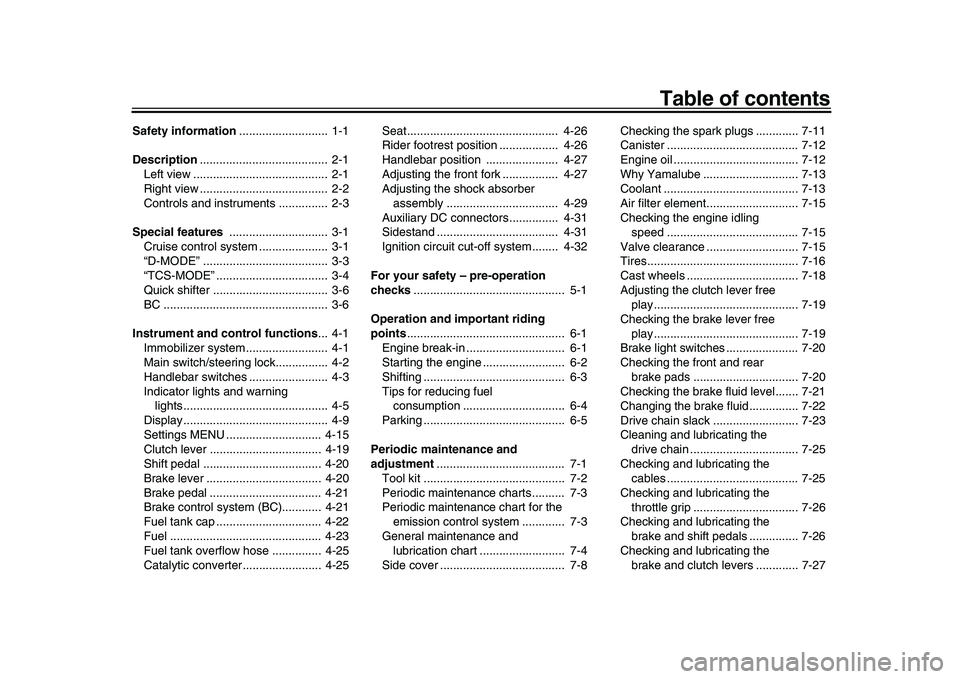
Table of contents
Safety information........................... 1-1
Description ....................................... 2-1
Left view ......................................... 2-1
Right view ....................................... 2-2
Controls and instruments ............... 2-3
Special features .............................. 3-1
Cruise control system .. ................... 3-1
“D-MODE” ...................................... 3-3
“TCS-MODE” .................................. 3-4
Quick shifter ................................... 3-6
BC .................................................. 3-6
Instrument and control functions ... 4-1
Immobilizer system ......................... 4-1
Main switch/steering lock................ 4-2
Handlebar switches .................... .... 4-3
Indicator lights and warning lights............................................ 4-5
Display............................................ 4-9
Settings MENU ............................. 4-15
Clutch lever .................................. 4-19
Shift pedal .................................... 4-20
Brake lever ................................... 4-20
Brake pedal ............... ................... 4-21
Brake control system (BC)............ 4-21
Fuel tank cap ................................ 4-22
Fuel .............................................. 4-23
Fuel tank overflow hose ............... 4-25
Catalytic converter........................ 4-25 Seat.............................................. 4-26
Rider footrest position .................. 4-26
Handlebar position ....
.................. 4-27
Adjusting the front fork ................. 4-27
Adjusting the shock absorber
assembly .................................. 4-29
Auxiliary DC connectors............... 4-31
Sidestand ..................................... 4-31
Ignition circuit cut-off system........ 4-32
For your safety – pre-operation
checks .............................................. 5-1
Operation and important riding
points ................................................ 6-1
Engine break-in .............................. 6-1
Starting the engine ......................... 6-2
Shifting ........................................... 6-3
Tips for reducing fuel consumption ............................... 6-4
Parking ........................................... 6-5
Periodic maintenance and
adjustment ....................................... 7-1
Tool kit ........................................... 7-2
Periodic maintenance charts.......... 7-3
Periodic maintenance chart for the emission control syst em ............. 7-3
General maintenance and lubrication chart .......................... 7-4
Side cover ...................................... 7-8 Checking the spark plugs ............. 7-11
Canister ........................................ 7-12
Engine oil ...................................... 7-12
Why Yamalube ............................. 7-13
Coolant ......................................... 7-13
Air filter element............................ 7-15
Checking the engine idling
speed ........................................ 7-15
Valve clearance ............................ 7-15
Tires.............................................. 7-16
Cast wheels .................................. 7-18
Adjusting the clutch lever free play............................................ 7-19
Checking the brake lever free
play............................................ 7-19
Brake light switches ...................... 7-20
Checking the front and rear
brake pads ................................ 7-20
Checking the brake fluid level....... 7-21
Changing the brake fluid............... 7-22
Drive chain slack .......................... 7-23
Cleaning and lubricating the drive chain ................................. 7-25
Checking and lubricating the cables ........................................ 7-25
Checking and lubricating the throttle grip ................................ 7-26
Checking and lubricating the
brake and shift pedals ............... 7-26
Checking and lubricating the brake and clutch levers ............. 7-27
BEA-28199-E0.book 1 ページ 2021年12月1日 水曜日 午後7時8分
Page 8 of 114
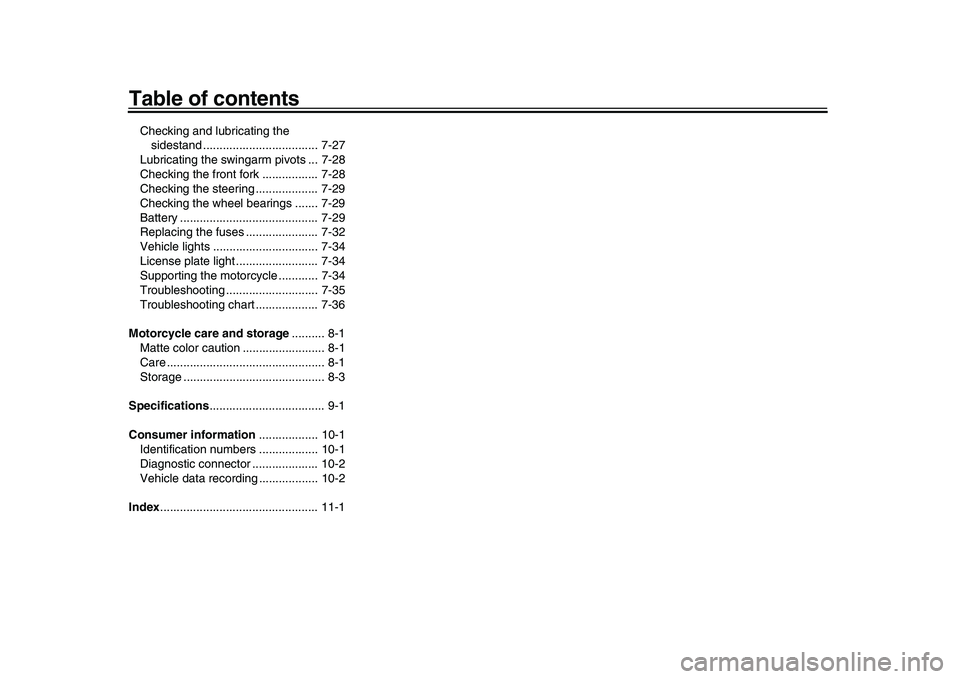
Table of contentsChecking and lubricating the sidestand ................................... 7-27
Lubricating the swingarm pivots ... 7-28
Checking the front fork ................. 7-28
Checking the steering ................... 7-29
Checking the wheel bearings ....... 7-29
Battery .......................................... 7-29
Replacing the fuses ...................... 7-32
Vehicle lights ................................ 7-34
License plate light ......................... 7-34
Supporting the moto rcycle ............ 7-34
Troubleshooting .......... .................. 7-35
Troubleshooting chart ................... 7-36
Motorcycle care and storage .......... 8-1
Matte color caution ......................... 8-1
Care ................................................ 8-1
Storage ........................................... 8-3
Specifications ................................... 9-1
Consumer information .................. 10-1
Identification numbers .................. 10-1
Diagnostic connector . ................... 10-2
Vehicle data recording .................. 10-2
Index ................................................ 11-1
BEA-28199-E0.book 2 ページ 2021年12月1日 水曜日 午後7時8分
Page 10 of 114
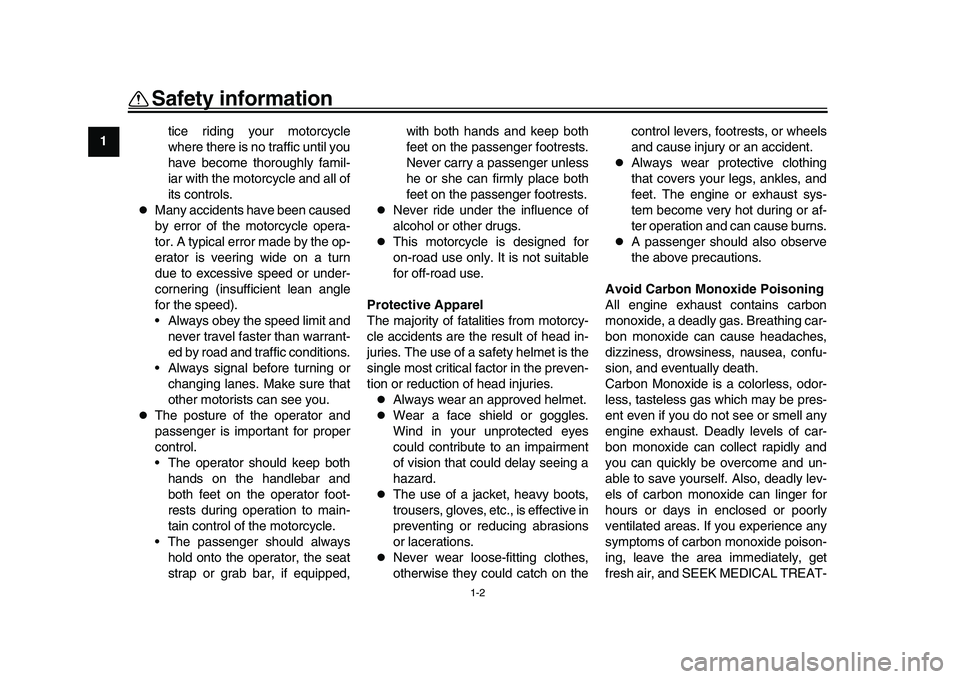
Safety information
1-2
1
2
3
4
5
6
7
8
9
10
11
12
13 tice riding your motorcycle
where there is no traffic until you
have become thoroughly famil-
iar with the motorcycle and all of
its controls.
Many accidents have been caused
by error of the motorcycle opera-
tor. A typical error made by the op-
erator is veering wide on a turn
due to excessive speed or under-
cornering (insufficient lean angle
for the speed).
Always obey the speed limit and
never travel faster than warrant-
ed by road and traffic conditions.
Always signal before turning or changing lanes. Make sure that
other motorists can see you.
The posture of the operator and
passenger is important for proper
control.
The operator should keep bothhands on the handlebar and
both feet on the operator foot-
rests during operation to main-
tain control of the motorcycle.
The passenger should always hold onto the operator, the seat
strap or grab bar, if equipped, with both hands and keep both
feet on the passenger footrests.
Never carry a passenger unless
he or she can firmly place both
feet on the passenger footrests.
Never ride under the influence of
alcohol or other drugs.
This motorcycle is designed for
on-road use only. It is not suitable
for off-road use.
Protective Apparel
The majority of fatalities from motorcy-
cle accidents are the result of head in-
juries. The use of a safety helmet is the
single most critical factor in the preven-
tion or reduction of head injuries.
Always wear an approved helmet.
Wear a face shield or goggles.
Wind in your unprotected eyes
could contribute to an impairment
of vision that could delay seeing a
hazard.
The use of a jacket, heavy boots,
trousers, gloves, etc., is effective in
preventing or reducing abrasions
or lacerations.
Never wear loose-fitting clothes,
otherwise they could catch on the control levers, footrests, or wheels
and cause injury or an accident.
Always wear protective clothing
that covers your legs, ankles, and
feet. The engine or exhaust sys-
tem become very hot during or af-
ter operation and can cause burns.
A passenger should also observe
the above precautions.
Avoid Carbon Monoxide Poisoning
All engine exhaust contains carbon
monoxide, a deadly gas. Breathing car-
bon monoxide can cause headaches,
dizziness, drowsiness, nausea, confu-
sion, and eventually death.
Carbon Monoxide is a colorless, odor-
less, tasteless gas which may be pres-
ent even if you do not see or smell any
engine exhaust. Deadly levels of car-
bon monoxide can collect rapidly and
you can quickly be overcome and un-
able to save yourself. Also, deadly lev-
els of carbon monoxide can linger for
hours or days in enclosed or poorly
ventilated areas. If you experience any
symptoms of carbon monoxide poison-
ing, leave the area immediately, get
fresh air, and SEEK MEDICAL TREAT-
BEA-28199-E0.book 2 ページ 2021年12月1日 水曜日 午後7時8分
Page 18 of 114
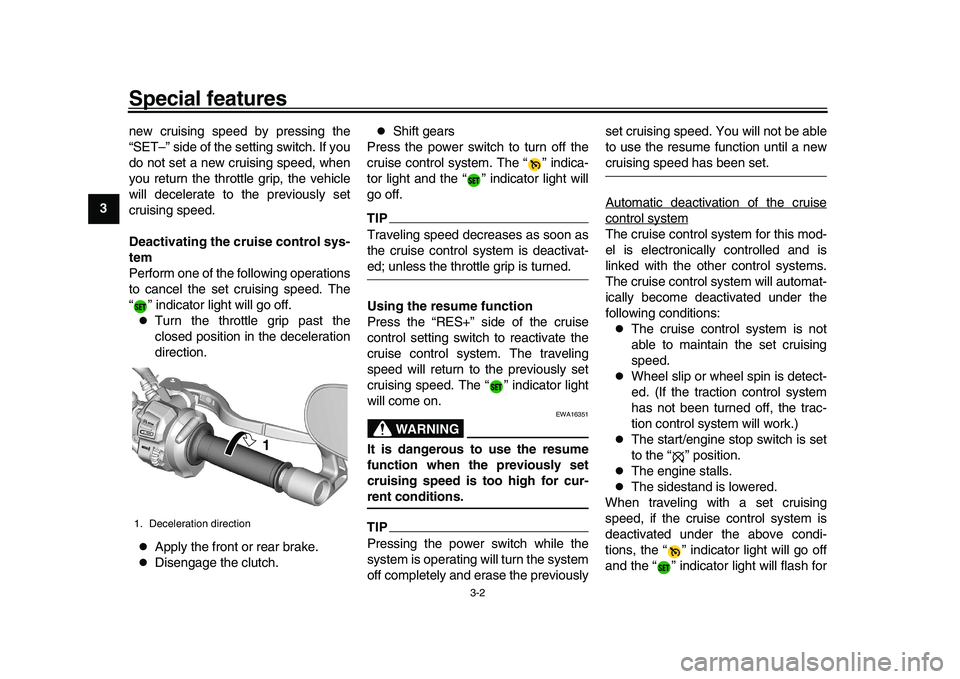
Special features
3-2
1
23
4
5
6
7
8
9
10
11
12
13 new cruising speed by pressing the
“SET–” side of the setting switch. If you
do not set a new cruising speed, when
you return the throttle grip, the vehicle
will decelerate to the previously set
cruising speed.
Deactivating the cruise control sys-
tem
Perform one of the following operations
to cancel the set cruising speed. The
“ ” indicator light will go off.
Turn the throttle grip past the
closed position in the deceleration
direction.
Apply the front or rear brake.
Disengage the clutch.
Shift gears
Press the power switch to turn off the
cruise control system. The “ ” indica-
tor light and the “ ” indicator light will
go off.
TIPTraveling speed decreases as soon as
the cruise control system is deactivat-ed; unless the throttle grip is turned.
Using the resume function
Press the “RES+” side of the cruise
control setting switch to reactivate the
cruise control system. The traveling
speed will return to the previously set
cruising speed. The “ ” indicator light
will come on.
WARNING
EWA16351
It is dangerous to use the resume
function when the previously set
cruising speed is too high for cur-rent conditions.TIPPressing the power switch while the
system is operating will turn the system
off completely and erase the previously set cruising speed. You will not be able
to use the resume function until a new
cruising speed has been set.
Automatic deactivation of the cruisecontrol systemThe cruise control system for this mod-
el is electronically controlled and is
linked with the other control systems.
The cruise control system will automat-
ically become deactivated under the
following conditions:
The cruise control system is not
able to maintain the set cruising
speed.
Wheel slip or wheel spin is detect-
ed. (If the traction control system
has not been turned off, the trac-
tion control system will work.)
The start/engine stop switch is set
to the “ ” position.
The engine stalls.
The sidestand is lowered.
When traveling with a set cruising
speed, if the cruise control system is
deactivated under the above condi-
tions, the “ ” indicator light will go off
and the “ ” indicator light will flash for
1. Deceleration direction
1
BEA-28199-E0.book 2 ページ 2021年12月1日 水曜日 午後7時8分
Page 20 of 114
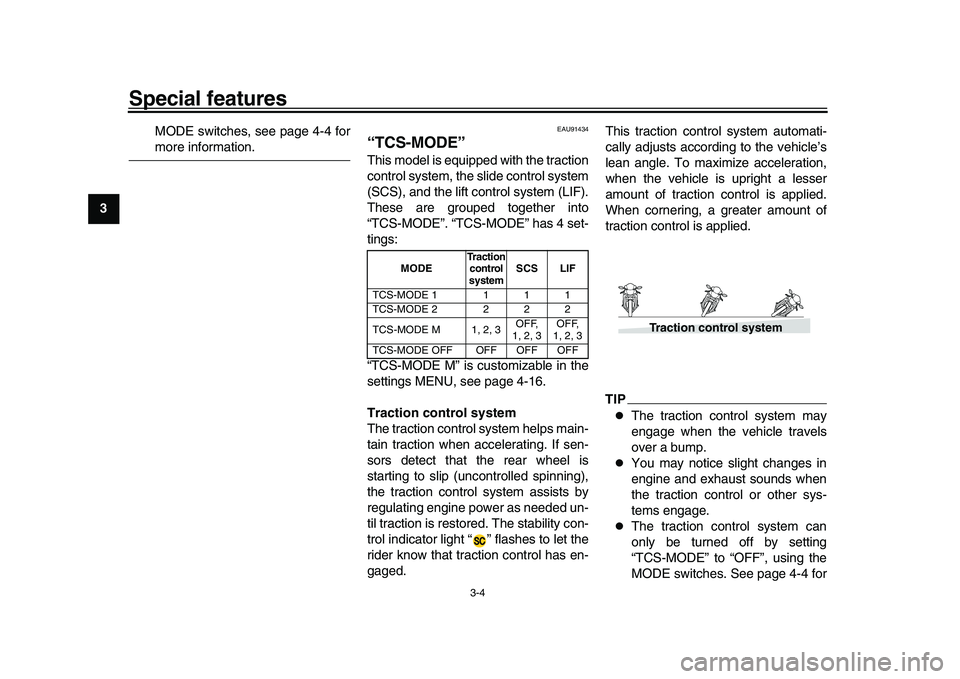
Special features
3-4
1
23
4
5
6
7
8
9
10
11
12
13 MODE switches, see page 4-4 for
more information.
EAU91434
“TCS-MODE”This model is equipped with the traction
control system, the slide control system
(SCS), and the lift control system (LIF).
These are grouped together into
“TCS-MODE”. “TCS-MODE” has 4 set-
tings:
“TCS-MODE M” is customizable in the
settings MENU, see page 4-16.
Traction control system
The traction control system helps main-
tain traction when accelerating. If sen-
sors detect that the rear wheel is
starting to slip (uncontrolled spinning),
the traction control system assists by
regulating engine power as needed un-
til traction is restored. The stability con-
trol indicator light “ ” flashes to let the
rider know that traction control has en-
gaged. This traction control system automati-
cally adjusts according to the vehicle’s
lean angle. To maximize acceleration,
when the vehicle is upright a lesser
amount of traction control is applied.
When cornering, a greater amount of
traction control is applied.
TIP
The traction control system may
engage when the vehicle travels
over a bump.
You may notice slight changes in
engine and exhaust sounds when
the traction control or other sys-
tems engage.
The traction control system can
only be turned off by setting
“TCS-MODE” to “OFF”, using the
MODE switches. See page 4-4 for
MODE
Traction
control
system SCS LIF
TCS-MODE 1 111
TCS-MODE 2 222
TCS-MODE M 1, 2, 3 OFF,
1, 2, 3 OFF,
1, 2, 3
TCS-MODE OFF OFF OFF OFF
Traction control system
BEA-28199-E0.book 4 ページ 2021年12月1日 水曜日 午後7時8分
Page 21 of 114
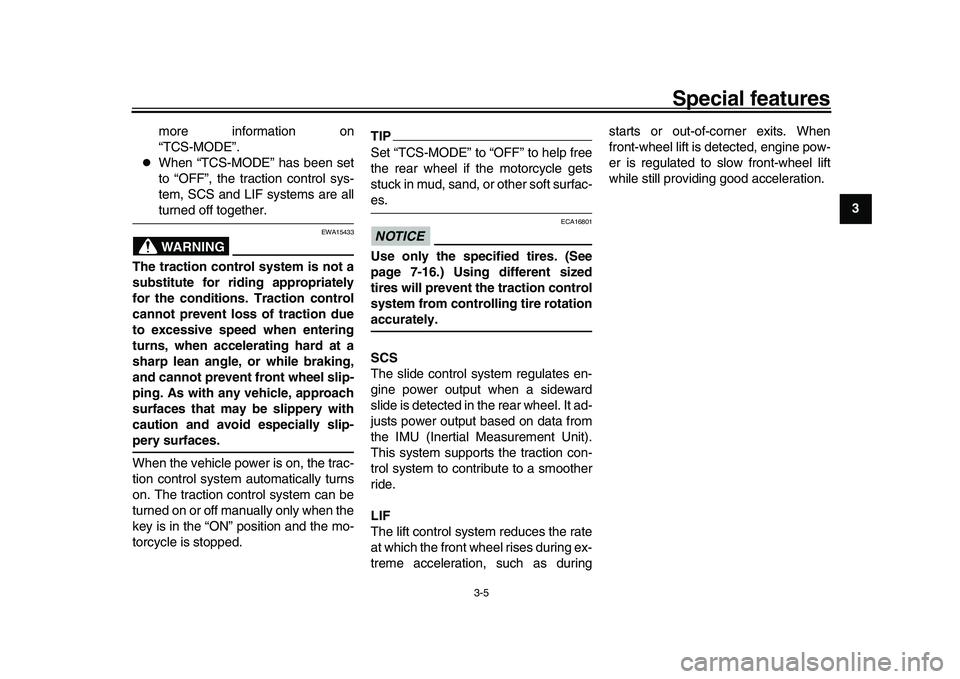
Special features
3-5
1
234
5
6
7
8
9
10
11
12
13
more information on
“TCS-MODE”.
When “TCS-MODE” has been set
to “OFF”, the traction control sys-
tem, SCS and LIF systems are allturned off together.WARNING
EWA15433
The traction control system is not a
substitute for riding appropriately
for the conditions. Traction control
cannot prevent loss of traction due
to excessive speed when entering
turns, when accelerating hard at a
sharp lean angle, or while braking,
and cannot prevent front wheel slip-
ping. As with any vehicle, approach
surfaces that may be slippery with
caution and avoid especially slip-pery surfaces.
When the vehicle power is on, the trac-
tion control system automatically turns
on. The traction control system can be
turned on or off manually only when the
key is in the “ON” position and the mo-
torcycle is stopped.
TIPSet “TCS-MODE” to “OFF” to help free
the rear wheel if the motorcycle gets
stuck in mud, sand, or other soft surfac-es.NOTICE
ECA16801
Use only the specified tires. (See
page 7-16.) Using different sized
tires will prevent the traction control
system from controlling tire rotationaccurately.
SCS
The slide control system regulates en-
gine power output when a sideward
slide is detected in the rear wheel. It ad-
justs power output based on data from
the IMU (Inertial Measurement Unit).
This system supports the traction con-
trol system to contribute to a smoother
ride.
LIF
The lift control system reduces the rate
at which the front wheel rises during ex-
treme acceleration, such as during starts or out-of-corner exits. When
front-wheel lift is detected, engine pow-
er is regulated to slow front-wheel lift
while still providing good acceleration.
BEA-28199-E0.book 5 ページ 2021年12月1日 水曜日 午後7時8分
Page 22 of 114
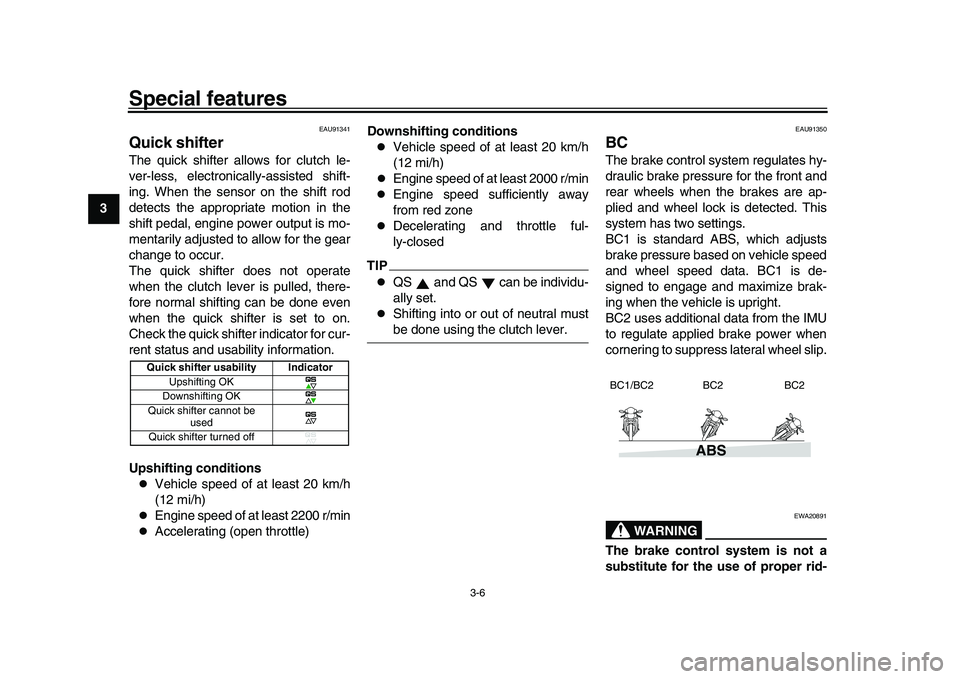
Special features
3-6
1
23
4
5
6
7
8
9
10
11
12
13
EAU91341
Quick shifterThe quick shifter allows for clutch le-
ver-less, electronically-assisted shift-
ing. When the sensor on the shift rod
detects the appropriate motion in the
shift pedal, engine power output is mo-
mentarily adjusted to allow for the gear
change to occur.
The quick shifter does not operate
when the clutch lever is pulled, there-
fore normal shifting can be done even
when the quick shifter is set to on.
Check the quick shifter indicator for cur-
rent status and usability information.
Upshifting conditions
Vehicle speed of at least 20 km/h
(12 mi/h)
Engine speed of at least 2200 r/min
Accelerating (open throttle) Downshifting conditions
Vehicle speed of at least 20 km/h
(12 mi/h)
Engine speed of at least 2000 r/min
Engine speed sufficiently away
from red zone
Decelerating and throttle ful-
ly-closed
TIP
QS and QS can be individu-
ally set.
Shifting into or out of neutral mustbe done using the clutch lever.
EAU91350
BCThe brake control system regulates hy-
draulic brake pressure for the front and
rear wheels when the brakes are ap-
plied and wheel lock is detected. This
system has two settings.
BC1 is standard ABS, which adjusts
brake pressure based on vehicle speed
and wheel speed data. BC1 is de-
signed to engage and maximize brak-
ing when the vehicle is upright.
BC2 uses additional data from the IMU
to regulate applied brake power when
cornering to suppress lateral wheel slip.
WARNING
EWA20891
The brake control system is not a
substitute for the use of proper rid-
Quick shifter usability Indicator
Upshifting OK
Downshifting OK
Quick shifter cannot be used
Quick shifter turned off
ABS
BC1/BC2 BC2 BC2
BEA-28199-E0.book 6 ページ 2021年12月1日 水曜日 午後7時8分
Page 23 of 114
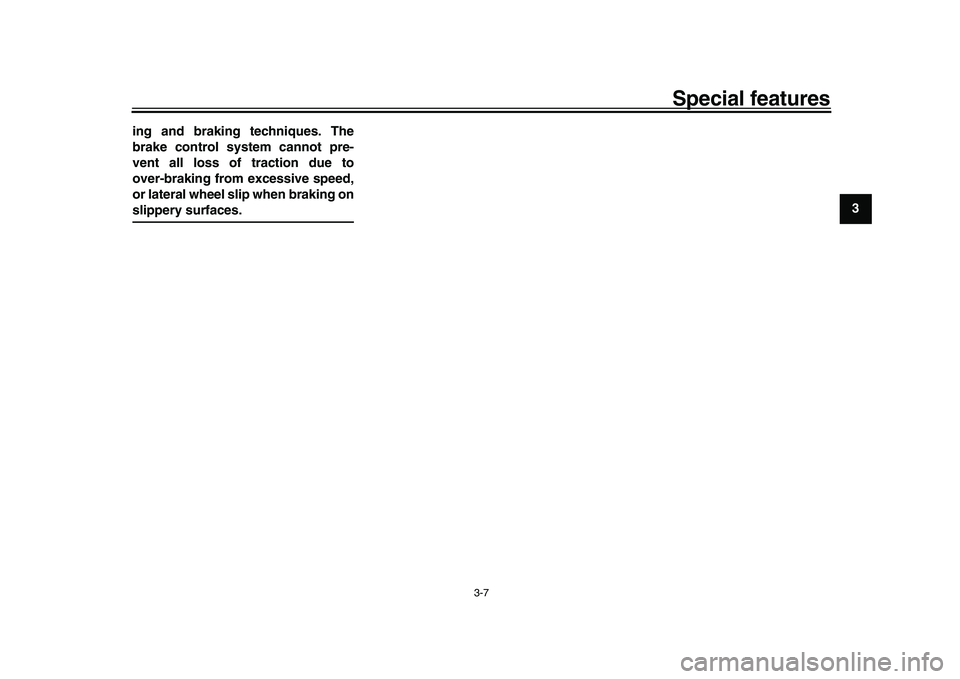
Special features
3-7
1
234
5
6
7
8
9
10
11
12
13
ing and braking techniques. The
brake control system cannot pre-
vent all loss of traction due to
over-braking from excessive speed,
or lateral wheel slip when braking on
slippery surfaces.
BEA-28199-E0.book 7 ページ 2021年12月1日 水曜日 午後7時8分
Page 26 of 114
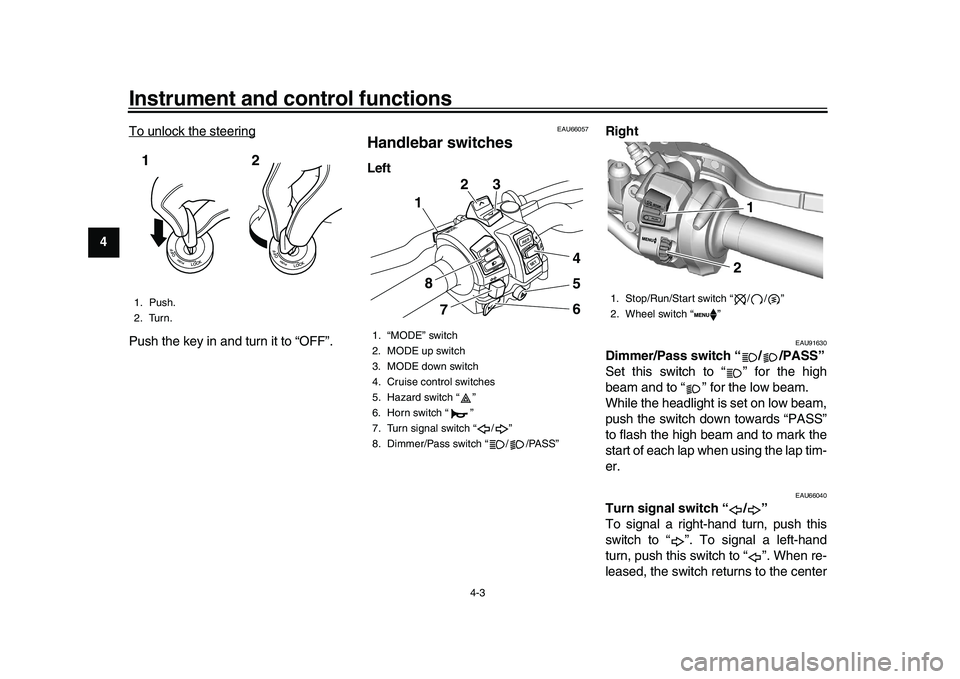
Instrument and control functions
4-3
1
2
34
5
6
7
8
9
10
11
12
13 To unlock the steering
Push the key in and turn it to “OFF”.
EAU66057
Handlebar switchesLeft
Right
EAU91630
Dimmer/Pass switch “ / /PASS”
Set this switch to “ ” for the high
beam and to “ ” for the low beam.
While the headlight is set on low beam,
push the switch down towards “PASS”
to flash the high beam and to mark the
start of each lap when using the lap tim-
er.
EAU66040
Turn signal switch “ / ”
To signal a right-hand turn, push this
switch to “ ”. To signal a left-hand
turn, push this switch to “ ”. When re-
leased, the switch returns to the center
1. Push.
2. Turn.12
1. “MODE” switch
2. MODE up switch
3. MODE down switch
4. Cruise control switches
5. Hazard switch “ ”
6. Horn switch “ ”
7. Turn signal switch “ / ”
8. Dimmer/Pass switch “ / /PASS”
RESSET
MODE
P
ASS
23
4
5
6
1
8 7
1. Stop/Run/Start switch “ / / ”
2. Wheel switch “ ”
1 1 12 2
BEA-28199-E0.book 3 ページ 2021年12月1日 水曜日 午後7時8分
Page 28 of 114
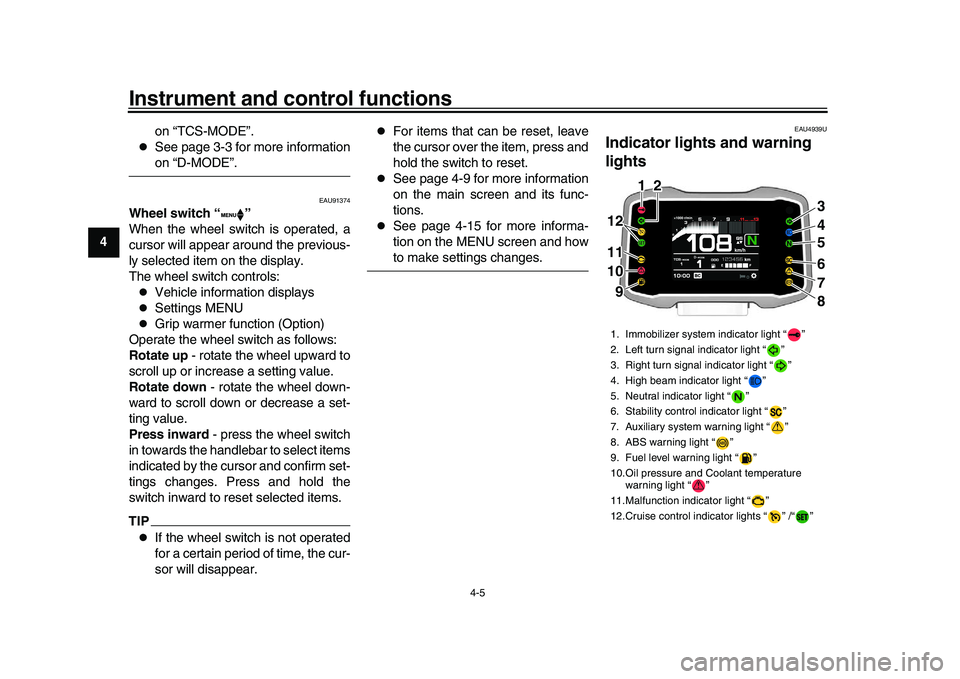
Instrument and control functions
4-5
1
2
34
5
6
7
8
9
10
11
12
13 on “TCS-MODE”.
See page 3-3 for more informationon “D-MODE”.
EAU91374
Wheel switch “ ”
When the wheel switch is operated, a
cursor will appear around the previous-
ly selected item on the display.
The wheel switch controls:
Vehicle information displays
Settings MENU
Grip warmer function (Option)
Operate the wheel switch as follows:
Rotate up - rotate the wheel upward to
scroll up or increase a setting value.
Rotate down - rotate the wheel down-
ward to scroll down or decrease a set-
ting value.
Press inward - press the wheel switch
in towards the handlebar to select items
indicated by the cursor and confirm set-
tings changes. Press and hold the
switch inward to reset selected items.
TIP
If the wheel switch is not operated
for a certain period of time, the cur-
sor will disappear.
For items that can be reset, leave
the cursor over the item, press and
hold the switch to reset.
See page 4-9 for more information
on the main screen and its func-
tions.
See page 4-15 for more informa-
tion on the MENU screen and howto make settings changes.
EAU4939U
Indicator lights and warning
lights1. Immobilizer system indicator light “ ”
2. Left turn signal indicator light “ ”
3. Right turn signal indicator light “ ”
4. High beam indicator light “ ”
5. Neutral indicator light “ ”
6. Stability control indicator light “ ”
7. Auxiliary system warning light “ ”
8. ABS warning light “ ”
9. Fuel level warning light “ ”
10.Oil pressure and Coolant temperature warning light “ ”
11.Malfunction indicator light “ ”
12.Cruise control indicator lights “ ” /“ ”
ABS
3
4
56
7
8
11 11
10 10 9
11 1 12
2 2
1012 12 12 9 9
BEA-28199-E0.book 5 ページ 2021年12月1日 水曜日 午後7時8分